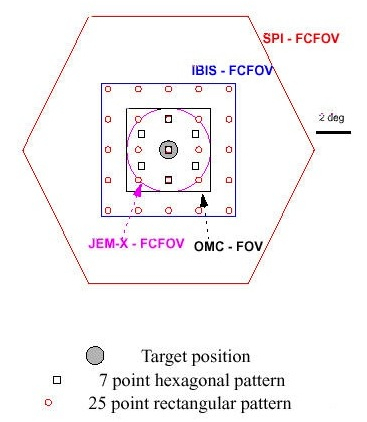 |
Three types of scientific observation strategies are distinguished for INTEGRAL :
The method of dithering is employed to suppress systematic effects on spatial and temporal background variations in the spectrometer and imager detectors. A controlled and systematic spacecraft dithering (Raster Scan) manoeuvre capability is required. Such manoeuvres consist of several off-pointings of the spacecraft pointing axis from the target. Two dithering patterns have been defined, which are applied in nominal science operation mode. These patterns are called hexagonal pattern and rectangular pattern (5 5 pattern), respectively. A schematic view of dithering patterns and instrument fully coded field of view is given in Figure 7.
The hexagonal pattern is used for a single known gamma-ray point source and covers sequentially the six edges of a hexagon and the nominal source location at individual steps of 2 , as shown in Figure 8. Observers are generally discouraged from using this mode, because it seriously compromises the imaging capabilities of SPI and also of IBIS, rendering the data useless for use in large mosaics. The use of the hexagonal mode must be well motivated and is accepted if the scientific goals require continuous monitoring of the main target by JEM-X. Such a strategy would however be at the expense of SPI data quality if there are even a few sources in the FOV. This observation mode was altered in November 2, 2005 to allow for a wandering Centre of dither Pattern (COP) offset to the hexagonal dither pattern. This COP pattern consists of 2 6 points that define two hexagons, centered around the original centre point of the dither pattern.
The rectangular 5 5 pattern is the default mode and is used for multiple point sources in the field of view, for sources with unknown locations, and for extended diffuse emissions. The pattern covers a 5 5 pointing pattern around the target with a step size of 2 .
During the first two years of operations, this mode consisted simply of a square pattern centred on the nominal target position. In this implementation, one pointing was with the source on-axis, and 24 other pointings with the source off-axis, each separated by 2.17 arranged on a rectangular grid. The roll angle between pointings was always 0 .
Afterwards, the pattern was optimised to reduce systematic effects in the IBIS images. This implies that for observations requiring several dither cycles, an offset between the centre of each dither cycle is introduced. This ensures that no pointing attitude is repeated over the course of the observation. Hence, the COP moves around in a pre-defined manner during the course of an observation. The COP pattern is parallel to the original 5 5 dither and consists of 7 7 points centred on the target, with a step size of 0.3 . Thus, the whole COP pattern fits within the inner 3 3 points of the original dither. The 49 points in the COP pattern allow for an observation time of 2.2Ms without repetition of a given pointing.
In addition to the moving COP, to further reduce systematic effects in deep mosaics, since June 2005 the orientation of the 5 5 pattern is set such that the axis of the dither pattern is rotated by 11.3 with respect to the instrument axes. As the instrument axes depend on the relative position of the Sun, the exact dither pattern pointing directions depend on the time of execution of the observation.
The most recent optimization to reduce systematic noise in mosaics involves a stepping in roll angle, and was implemented for the first time at the end of November 2007 in revolution 624. With this strategy, the roll angle for an observation with repetitions of the 5 5 pattern spans the range from to , in steps of .
Scanning strategies are used to cover large parts of the sky for monitoring purposes or for detecting diffuse emission in what is called ``custom modes''. Among these, the ``Galactic Plane Scan'' has been codified as follows. At weekly intervals, a saw-tooth-path scan inclined at 21 with regard to the galactic equator is employed, see Figure 9. Each scan consists of a series of individual exposures of 965 s each. The individual exposures are separated by 6 along the scan path.
Staring observations are used for calibration purposes or in circumstances that require staring on-axis observations of a source, such as in studies of time variability or QPOs. The use of this mode is strongly discouraged, because it very seriously compromises the imaging capabilities of SPI, IBIS, and JEM-X, rendering the data useless for use in large mosaics, and in particular for the study of high energy emission from celestial sources using SPI.